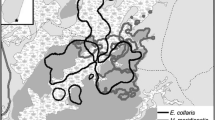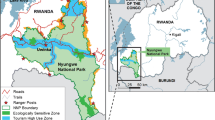Abstract
Studies of primate diets usually focus on differences that distinguish species or populations. However, variation in diet can occur at a more local level of groups within a population, especially in a non-homogeneous habitat. I compared dietary variation in food composition and toughness across groups of 2 lemur species in Beza Mahafaly special reserve, Madagascar. Beza Mahafaly contains an 80-ha reserve (Parcel 1) that, while small, hosts a dense population of Lemur catta (ring-tailed lemurs) and Propithecus verreauxi verreauxi (sifakas). Microhabitats in the eastern vs. western sides of the parcel are structurally and floristically distinct. Sifakas in this parcel have small, discrete home ranges and are morphological folivores. For these reasons, I expected that the 6 groups studied would eat a different menu of food plants but with similar toughness values. Ring-tailed lemurs have comparatively large, overlapping home ranges, and I expected that the 5 study groups would eat similar foods. Despite living in different microhabitats across the parcel, sifakas exhibit high dietary uniformity both in dietary plant species composition and the toughness of the foods. Food selection in sifakas operates on two distinct levels. Sifaka groups share many key food species that appear independent of local abundances, but the ranking of the foods within each group appears related to availability. Ring-tailed lemur groups are more heterogeneous in the composition of their diets relative to sifakas, though the time spent feeding on individual foods reveals a marked preference for the fruits of Tamarindus indica by all groups. Food toughness is consistent across the parcel with the exception of the most western group. Ring-tailed lemurs are highly specific feeders, but indiscriminate nibblers. Sifakas are targeted, balanced feeders. There does not appear to be a consistent microhabitat effect operating across species. Differences within sifaka and ring-tailed lemur populations in food composition and toughness, however, correspond to an east-west microhabitat gradient. Measures of dietary flexibility must take into account not only the plant species consumed and the different parts eaten but also their associated food properties and proportion of time spent feeding on them.
Similar content being viewed by others
REFERENCES
Darvell, B. W., Lee, P. K. D., Yuen, T. D. B., and Lucas, P. W. (1996). A portable fracture toughness tester for biological materials. Meas. Sci. Technol. 7: 954–962.
Gould, L., Sussman, R., and Sauther, M. (1999). Natural disasters and primate populations: The effects of a 2-year drought on a naturally occurring population of ring-tailed lemurs (Lemur catta) in southwestern Madagascar. Int. J. Primatol. 20: 69–84.
Hemingway, C. A. (1998). Selectivity and variability in the diet of Milne-Edwards' sifakas (Propithecus diadema edwardsi): Implications for folivory and seed-eating. Int. J. Primatol. 19: 355–377. http://mobot.mobot.org/W3T/Search/vast.html.
Kubzdela, K. S. (1996). The effects of group size on group cohesion and intra-group feeding competition in sifakas. Am. J. Phys. Anthrop. (Suppl.) 22: 143.
Kubzdela, K. S. (1997). Sociodemography in diurnal primates: The effects of group size and female dominance rank on intra-group spatial distribution, feeding competition, female reproductive success, and female dispersal patterns in white sifaka, Propithecus verreauxi verreauxi, PhD Dissertation, University of Chicago, Chicago.
Overdorff, D. J., and Strait, S. G. (1998). Seed handling by three prosimian primates in southeastern Madagascar: Implications for seed dispersal. Am. J. Primatol. 45: 69–82.
Powzyk, J. A. (1996). A comparison of feeding strategies between the sympatric Indri indri and Propithecus diadema diadema in primary rain forest. Am. J. Phys. Anthrop. (Suppl.) 22: 190.
Richard, A. F., Dewar, R. E., Schwartz, M., and Ratsirarson, J. (2000). Mass change, environmental variability and female fertility in wild Propithecus verreauxi. J. Hum. Evol. 39: 381–391.
Richard, A. F., Rakotomanga, P., and Schwartz, M. (1991). Demography of Propithecus verreauxi at Beza Mahafaly, Madagascar: Sex ratio, survival, and fertility, 1984-1988. Am. J.Phys. Anthrop. 84: 307–322.
Sauther, M. L. (1998). Interplay of phenology and reproduction in ring-tailed lemurs: Implications for ring-tailed lemur conservation. Folia Primatol. 69 (Suppl. 1): 309–320.
Sauther, M. L., Sussman, R.W., and Gould, L. (1999). The socioecology of the ringtailed lemur: Thirty-five years of research. Evol. Anthrop. 8: 120–132.
Sussman, R. W. (1987). Species-specific dietary patterns in primates and human dietary adaptations.In Kinzey W. G. (ed.), The Evolution of Human Behavior: Primate Models, State University of New York Press, Albany, pp. 151–179.
Sussman, R.W. (1991). Demography and social organization of free-ranging Lemur catta in the Beza Mahafaly Reserve, Madagascar. Am. J. Phys. Anthrop. 84: 43–58.
Sussman, R.W., and Rakotozafy, A. (1994). Plant diversity and structural analysis of a tropical dry forest in southwestern Madagascar. Biotropica 26: 241–254.
Tan, C. L. (1999). Group composition, home range size, and diet of three sympatric bamboo lemur species (Genus Hapalemur) in Ranomafana National Park, Madagascar. Int.J. Primatol. 20: 547–566.
Ungar, P. S. (1995). Fruit preferences of four sympatric primate species at Ketambe, Northern Sumatra, Indonesia. Int. J. Primatol. 16: 221–245.
Yamashita, N. (1996). Seasonality and site-specificity of mechanical dietary patterns in two Malagasy lemur families (Lemuridae and Indriidae). Int. J. Primatol. 17: 355–387.
Yamashita, N. (2000). Mechanical thresholds as a criterion for food selection in two prosimian primate species. In Spatz H.-C., and Speck T. (eds.), Proceedings of the 3rd Plant Biomechanics Conference, Freiburg-Badenweiler August 27th to September 2nd, Thieme Verlag, Stuttgart, pp. 590–595.
Author information
Authors and Affiliations
Rights and permissions
About this article
Cite this article
Yamashita, N. Diets of Two Lemur Species in Different Microhabitats in Beza Mahafaly Special Reserve, Madagascar. International Journal of Primatology 23, 1025–1051 (2002). https://doi.org/10.1023/A:1019645931827
Issue Date:
DOI: https://doi.org/10.1023/A:1019645931827




